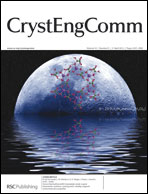Two organic–inorganic hybrid hexa-CuII substituted sandwich-type arsenotungstates [Cu(en)2(H2O)]2 [Cu(en)2][Cu6(en)2(H2O)2(B-α-AsW9O34)2]·en·9H2O (1) and [Cu(dap)2]3[Cu6(dap)2(H2O)2(B-α-AsW9O34)2]·4H2O (2) (en = ethylenediamine, dap = 1,2-diaminopropane) have been hydrothermally prepared and structurally characterized by elemental analysis, IR spectra, powder X-ray diffraction (XRD), thermogravimetric analysis (TGA) and single-crystal X-ray diffraction. 1 is an organic–inorganic hybrid 1-D chain constructed from hexa-CuII substituted [Cu6(en)2(H2O)2(B-α-AsW9O34)2]6− sandwich-type units and [Cu(en)2]2+ linkers whereas 2 shows the six-connected 3-D extended framework built by hexa-CuII sandwiched [Cu6(dap)2(H2O)2(B-α-AsW9O34)2]6− units and [Cu(dap)2]2+ connectors. To our knowledge, 1 and 2 represent the first organic–inorganic hybrid high-dimensional arsenotungstates containing hexa-CuII sandwiched polyoxometalate units. The results of magnetic susceptibility measurements demonstrate that 1 and 2 indicates the ferromagnetic couplings within CuII centers. The photocatalytic measurements illustrate that 1 and 2 can to some extent inhibit the photodegradation of rhodamine-B (RhB).

You have access to this article
 Please wait while we load your content...
Something went wrong. Try again?
Please wait while we load your content...
Something went wrong. Try again?


 Please wait while we load your content...
Please wait while we load your content...